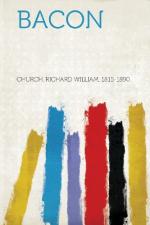In the next place, though the prominence which he gave to the doctrine of Induction was one of those novelties which are so obvious after the event, though so strange before it, and was undoubtedly the element in his system which gave it life and power and influence on the course of human thought and discovery, his account of Induction was far from complete and satisfactory. Without troubling himself about the theory of Induction, as De Remusat has pointed out, he contented himself with applying to its use the precepts of common-sense and a sagacious perception of the circumstances in which it was to be employed. But even these precepts, notable as they were, wanted distinctness, and the qualities needed for working rules. The change is great when in fifty years we pass from the poetical science of Bacon to the mathematical and precise science of Newton. His own time may well have been struck by the originality and comprehensiveness of such a discriminating arrangement of proofs as the “Prerogative Instances” of the Novum Organum, so natural and real, yet never before thus compared and systematized. But there is a great interval between his method of experimenting, his “Hunt of Pan”—the three tables of Instances, “Presence,” “Absence” and “Degrees, or Comparisons,” leading to a process of sifting and exclusion, and to the First Vintage, or beginnings of theory—and say, for instance, Mill’s four methods of experimental inquiry: the method of agreement, of differences, of residues, and of concomitant variations. The course which he marked out so laboriously and so ingeniously for Induction to follow was one which was found to be impracticable, and as barren of results




